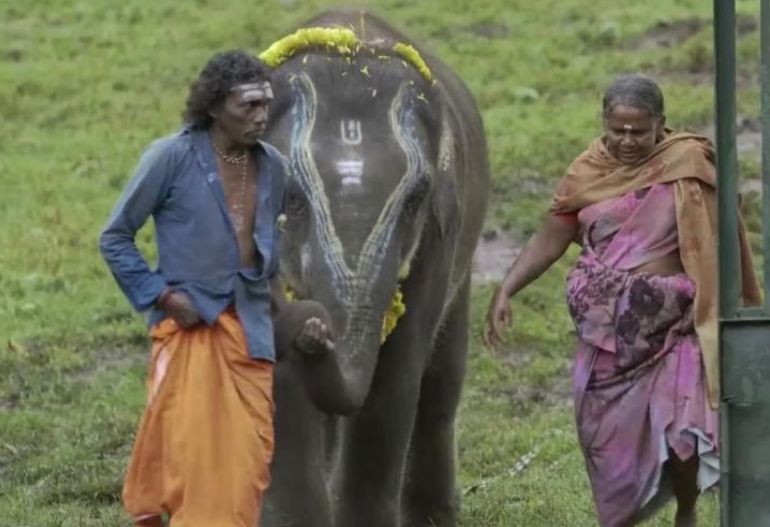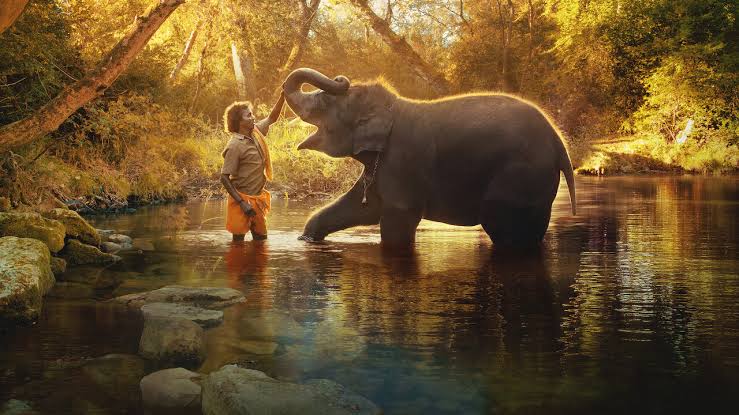The ‘Gen-Z’ are born and brought up in an era of a technological boom. Versions of any gadget, software and even life keep updating. Amid such fast-moving life, the Oscar-winning Elephant Whisperers will take them back to their roots. The magnum opus will imbibe a sense of ‘love and respect’ in them.
The Short Documentary
The thirty-nine-minute documentary was released on December 8, 2022, on the OTT platform Netflix. It has been directed by filmmaker Kartiki Gonsalves and is produced by Sikhya Entertainment. The film had its world premiere on 9 November 2022 at DOC NYC Film Festival, a film festival for documentaries in the United States.
In the 95th Academy Awards, this film won the awards in the Short Documentary category.
The movie celebrates lost values embedded in the Bhartiya culture
Bomman and Belli, an indigenous couple, are entrusted with caring for Raghu, an orphaned young elephant, in the film The Elephant Whisperers. They go to tremendous lengths to make sure the weak, damaged baby survives and matures into a healthy adolescent. The couple and the elephant grow to have a close relationship. The documentary emphasises the area’s natural splendour with the couple living in the Mudumalai National Park in the lovely Indian state of Tamil Nadu. It investigates how indigenous people live in peace with nature. The couple belongs to the Kattunayakan indigenous tribal group, who have been taking care of elephants for ages.
As soon as the couple and the young elephant (hero of the story) ‘Raghu’ are introduced, his human mother Belli speaks about her life. She says “I have experienced many losses in my life. My ex-husband was killed by a tiger. This left me feeling scared of the forests. I get petrified when I see a tiger.”
But, she says, “I am a tribal woman, and our people come from the heart of the forest.”
She adds further, “We walk barefoot in the forest. This is our way of showing respect to it. We live off the forest but also protect it. For us Kattunayakans, the well-being of the forest is all that matters,” she says.
This display of respect by the tribals will teach youngsters a lesson. They will learn how our ancestors lived in such places and how humble they were. It can be an important trait to carry forward amid the ruthlessly growing humans who care about nature only for the permits and grants. The sacred feeling with which Bellie tells about the forest will leave viewers spellbound. They will learn to respect nature and wildlife as well.
The documentary is not just about natural beauty or the co-existence of humans and animals just like the famous character from our childhood comics ‘Mougli’. It is about the restoration of a tribe of animals (in this case an elephant) which would rather go extinct. The story is also about a tribe (Kattunayakans) who have been serving and protecting these mammals for so many years, they never thought of moving out and changing their lives altogether. These tribes are living in the forests, using techniques and measures which our ancestors would have used to survive. They call themselves ‘Mahaut’ (one who guides an elephant), and the story is about them and their way of life.
The story will also bring all the feminine qualities of males watching the film. Yes, feminine qualities, those who want to get it must watch Boman. The film also presents the progressive thoughts among tribals who treat both males and females equally. There is no discrimination among their responsibilities. This shows the male-female bifurcation is a far new concept.
The readers will be amazed to find the relationship of Boman (the Mahaut) with Raghu (the elephant). They bathe together, sleep together, walk together and even cry together.
For instance, in one scene Boman asks Raghu, “Who is the best elephant, Is it Raghu, Is it you Raghu?” and the elephant nods his trunk and cuddles with Boman.
They can be seen lying on bare grassland over each other. In one shot, Boman and Ragu share the same umbrella and viewers will not stop giggling watching it. Like a child walks holding his fathers finger, Raghu walks with Boman holding his stick with his trunk.
Readers should not miss Raghu’s football skills as he kicks the ball both with his trunk and legs. It is an absolute delight to watch it on screen.
Raghu is like a naughty young boy who is throw tantrums in eating food and milk but will enthralling in joy on getting his coconut and jaggery, just the way children would have done after getting their pack of chocolates. He would open up the tap to drink water, would splash water on Boman and whatnot. It’s fun to watch the love between Boman and Raghu as if they are a Father-Son duo.

Later in the movie, the caregivers Boman and Bellie are given the responsibility of taking care of another baby elephant named ‘Ammu’. As they work for the forest department with their elephant rehabilitation camp. All the lost, abandoned, orphaned and injured elephants are kept here only.
Raghu like a human child would get angry with his parents if he sees them standing near Ammu or giving their love to him. Soon he accepts him and they all live like a family.
The film describes a ceremony where decorated elephants move to the temple of lord Ganesha and offer prayers. Boman says, “I am proud of being both a priest and Mahaut. We pray to lord Ganesha and to me seeing an elephant is like seeing lord Ganesha”.
The documentary also shows the growing relationship of the aged couple Boman and Bellie. They get married in the forest and a beautiful photoshoot takes place with Raghu and Baby Ammu.

As soon as Raghu reaches adolescence, the department asks Boman to hand him over to other caregivers in the village. It is hurtful to watch the separation. Viewers will not be able to stop themselves from crying. Ammu grunts and cries on separation and Raghu runs back to Boman, Bellie and Ammu leaving his new Mahaut. The seen will imbibe a sense of togetherness.
Boman and Bellie begged the authorities to allow Raghu to live with them. They cry about the separation saying they were alone in life when Raghu came in, they treated him like their son, and they prayed for him but Raghu had to go. For the following days, they did not eat meals, even Ammu joined them in this pain.
Somehow they manage to live without Raghu.
The movie ends with a message of how humans infiltrated nature to ruin the lives of animals. And how climate change has caused water supplies in the region to dry up, sending the elephants into areas of human habitation in search of a drink.
There are a number of takeaways from the film for the younger generations. All the parents must show this film to their children and should watch it with them. They will learn about the lost tribes of (Mahaut) who have been serving elephants for ages. It also teaches them about the traditional values of tribal people who come from the heart of the forest. It is exciting to watch their way of life. The family values which are often seen lost in cities could surely get a rejuvenation from the film.
The movie presents the best version of Bharat. Now that is has bagged Oscars we should be proud of the team who showed this to the world.
The director is an animal lover
Kartiki Gonsalves meet that same baby elephant, Raghu in October 2017 his life spurred her to make the film. He was just three-months-old when she first met him.
She said “I spent about a year and a half with him when he was a tiny baby before this became a documentary.”
“My family explored streams and beaches, natural history museums and aquariums. My parents would bundle us up — my sister and I — and would take us out to state parks and camping sites,” she says.
Her mother loved animals and her father was a photographer. Her grandmother led school trips to local nature reserves.
After graduating with a degree in visual communications from GRD College of Science in the southern Indian city of Coimbatore in 2007, Gonsalves went on to study photography, specializing in wildlife, travel and culture.
“I was in the process of moving back to my hometown of Ooty,” she says. And she stopped at the Mudumalai Tiger Reserve, close to the Theppakadu Elephant camp. It was established more than a hundred years ago, and she’d been visiting it since she was a child. “While driving home, I met Raghu as a three-month-old calf,” she recalls.
“This documentary was made because I fell in love with Raghu first,” she says.
“The three of us would happily splash along the river, and I would spend hours scrubbing him and rubbing his tongue. He absolutely loves his tongue being rubbed. He enjoyed pulling my hair and splashing around in the water. We would stick our tongues at each other.”















Comments